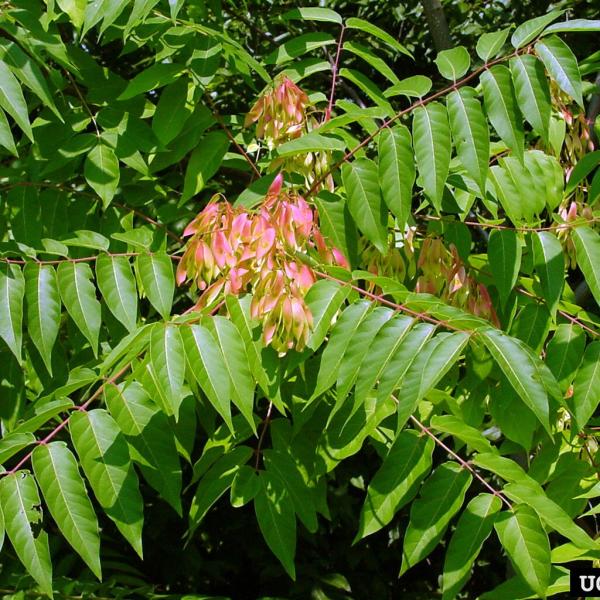
Author: Elizabeth Spinney, Invasive Plant Coordinator, Vermont Department of Forests, Parks & Recreation, September 2021
In mid-August, a concerned community member brought to the attention of scientists, the presence of an invasive insect. The insect, spotted lanternfly, had never been reported before in Vermont, and was first detected in the United States in 2014 in Pennsylvania, but has spread across the eastern US to 8 states. It hitchhikes on just about anything from wooden pallets, slabs of stone, cars, campers, and even things like backyard grills. What fate awaits it when it travels abroad largely depends on what plant species are available for it to utilize. It can survive on over 70 species of plants, most notable maples, walnuts, oaks, hops, grapes, and apples, often damaging those important crop and hardwood species. However, it appears that a favored plant, invasive Tree-of-Heaven (Ailanthus altissima) may be important in assisting the spread of this insect.
Tree-of-Heaven evolved in China, as did spotted lanternfly. The tree was introduced to the United States in the 1700s as an ornamental plant popular in urban settings (fast-growing, resistant to pollution, provides shade), and was widely planted in the Northeast and California, and has spread to most states.
There are a number of locally evolved trees that look similar to the invasive Tree-of-Heaven: white ash (Fraxinus americana), black ash (Fraxinus nigra), staghorn sumac (Rhus typhina), smooth sumac (Rhus glabra), and butternut (Juglans cinerea). Luckily there are a few ways to distinguish invasive Tree-of-Heaven from its respective local look-alikes:
Leaves
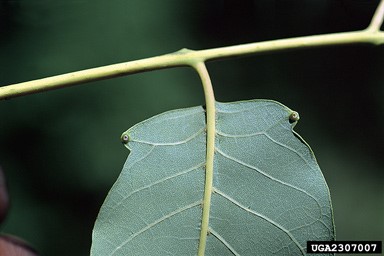
Ailanthus altissima leaflet, showing the glandular teeth and gland at the base. Photo credit: James H. Miller, USDA Forest Service, Bugwood.org
- Tree-of-Heaven (invasive) leaves are pinnately compound, alternately arranged, smooth margin with glandular teeth at the base, 1’-2’+ in length, with ~11-41 leaflets per leaf
- White ash (local) leaves are pinnately compound, oppositely arranged, mostly smooth or slightly serrated margin, 8-12” in length, with 5-9 leaflets per leaf
- Black ash (local) leaves are pinnately compound, oppositely arranged, finely serrated margins, 9-16” in length, with 7-13 leaflets per leaf
- Staghorn sumac (local) leaves are compound, alternately arranged, sharply serrated margins, 6-16” in length, with 9-27 leaflets per leaf
- Smooth sumac (local) leaves are compound, alternately arranged, serrated margins, 8-18” in length, with 9-23 leaflets per leaf
- Butternut (local) leaves are compound, alternately arranged, finely serrated margins, 16-28” in length, with 11-17 leaflets per leaf
Fruit
- Tree-of-Heaven (invasive) samaras are oblong, and have a single seed in the center of the papery wing
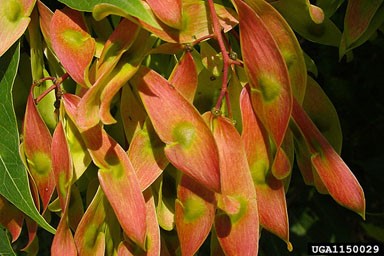
The winged samaras of Ailanthus altissima oblong, papery, and have a central, single seed. Photo credit: Chuck Bargeron, University of Georgia, Bugwood.org. - White ash (local) samaras are paddle shaped, with thick, wide seeds
- Black ash (local) samaras are paddle shaped, and the seeds are thin
- Staghorn sumac (local) fruits are small, red and fuzzy and arranged on a panicle
- Smooth sumac (local) fruits are small, red and fuzzy and arranged on a panicle
- Butternut (local) fruits are green, round - but oblong and pointed, and clustered together
Height

Ailanthus altissima will grow just about anywhere. Photo credit: Ian Trueman, University of Wolverhampton, Bugwood.org
- Tree-of-Heaven (invasive) are a large sized tree, ranging from 60-80’ in height
- White ash (local) are a large sized tree, averaging 50-80’ in height, but capable of much larger heights
- Black ash (local) are a medium sized to large sized tree, averaging 40-70’ in height
- Staghorn sumac (local) are a shrub, averaging 15-25’ in height
- Smooth sumac (local) are a shrub, ranging from 3-15’+ in height
- Butternut (local) are a medium sized tree, averaging 40-60’ in height
Leaf scars
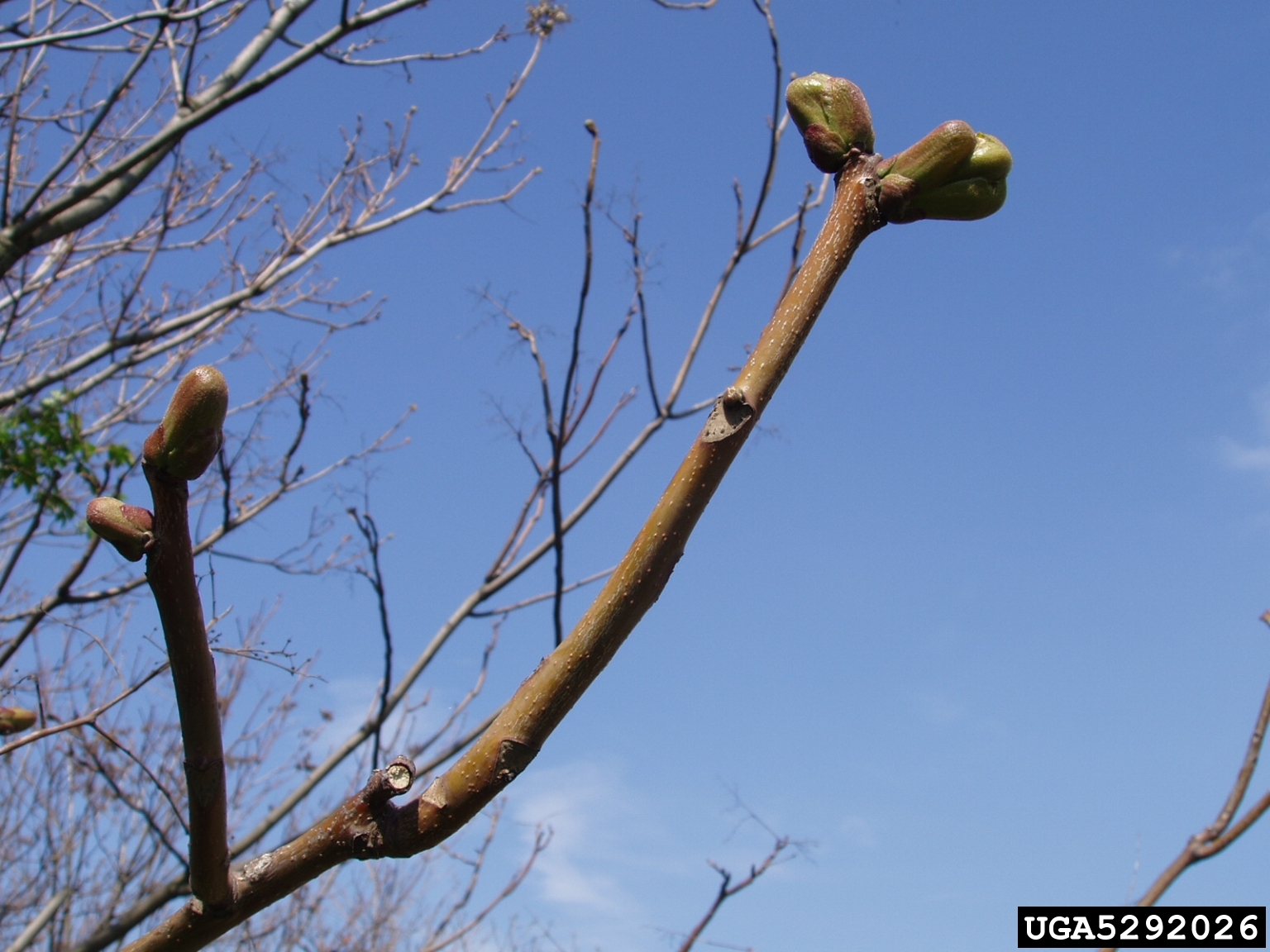
Ailanthus altissima leaf scar. Photo credit: Jan Samanek, Phytosanitary Administration, Bugwood.org
- Tree-of-Heaven (invasive) have large “v” or heart shaped leaf scars
- White ash have “c” shaped leaf scars
- Black ash have almost “o” shaped leaf scars
- Staghorn sumac leaf scars are a strongly curved horseshoe shape
- Smooth sumac leaf scars almost encircle the buds
- Butternut have a wooly fringe across the top of the leaf scar with no notch, and almost looks like a sheep or goat’s face
Other Characteristics
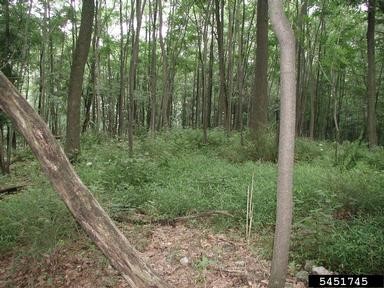
Ailanthus altissima infestation. Photo credit: Leslie J. Mehrhoff, University of Connecticut, Bugwood.org
- Tree-of-Heaven (invasive) crushed leaves and male flowers have a skunk-like rotten smell
- White ash (local) bark is light gray and uniformly fissured
- Black ash (local) bark is gray and scaly or flaky
- Staghorn sumac (local) gets its name from the velvety dense hairs that cover much of the plant
- Smooth sumac (local) is one of the first plants whose foliage turns color in the fall, going a bright red
- Butternut (local) in the Northeast will often exhibit signs of butternut canker
Tree-of-Heaven can establish dense canopies, reducing understory cover diversity, and can be found in forests, forest edges, fields, and human-impacted areas. These trees are short lived, have been documented producing fruit after two years (though not commonly), and can grow 8’ in the first year of growth. Seeds are easily wind dispersed and highly viable, and the tree can reproduce from seed or vegetatively. While shade-intolerant, it has been documented as a pioneer species in forests defoliated or impacted by biotic or abiotic stressors. Where it does grow, the trees release allelopathic chemicals, which reduces competition and will persist in the soil, inhibiting succession. This documented behavior and the continued spread of these trees in Vermont are reasons they are listed as Class B Noxious Weeds in Vermont.
To learn more about invasive Tree-of-Heaven, check out VTinvasives.org and these additional resources:
Tree-of-Heaven
Centre for Agriculture and Biosciences International
Species comparisons
Minnesota Wildflower – White Ash
Minnesota Wildflower – Black Ash
Minnesota Wildflower – Staghorn Sumac
Minnesota Wildflower – Smooth Sumac